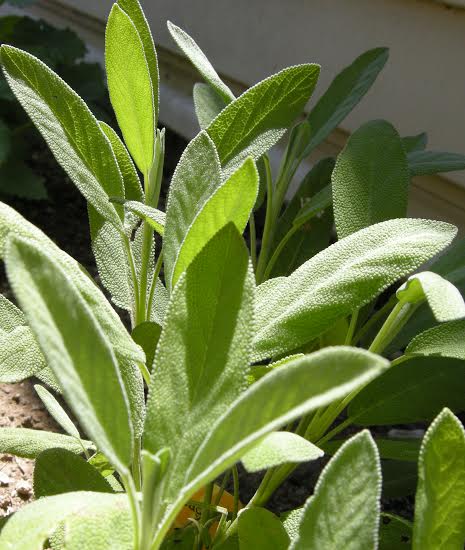
If you had turkey or chicken last Christmas it’s likely sage was a key ingredient for your stuffing. If you have some sage left over you may be surprised to hear how it can be used not only as a food flavour, but also as a medicine.
Sage's botanical name is Salvia officinalis, and from ancient times it has been used as a medicine. In recent years scientific research has explored the ways sage can be used to heal. The components of the herb which make it work medicinally are called the active constituents. The way a herb is prepared effects the availability of those active constituents to the body. So a tea will make some active constituents available, while other active constituents are more available in a liquid extract, and others in an extract of oil.
Medicinally Sage can be used in many ways; including the inclusion of the fresh herb in food, dried as a tea, in tablet or capsules, as a fluid extract and as an oil infusion. Additionally, the essential oil of Sage has been shown to have Antimicrobial and Antioxidant properties [1, 2]. Traditionally used to heal in many skin diseases, recent research showed the sage essential oils are antifungal and anti-inflammatory [3].
The liquid extract and essential oil of Sage has been shown to help improve memory [4] and is being studied to help prevent and delay the decline of the brain in dementia [4, 5]. I wonder if there is a connection here to the word “Sage” to describe a person of great age wisdom.
Many herbal medicines are currently being researched to find out how much they help to lower or stabilise blood sugar levels, as high blood sugar levels are a problem in Diabetes. Reducing excessive blood sugars helps prevent type 2 diabetes, and helps manage diabetes. Sage leaves or Sage tea does lower blood sugar levels [6, 7, 8, 9], and have been cited as having an effect like Metformin [7] which is a pharmaceutical medicine used to help people with Type 2 diabetes. Although some researchers believe Sage is mainly used to help prevent Type 2 diabetes [7].
Sage is also effective in helping decrease excessive sweating. This is especially useful for women who suffer from hot flushes at menopause [10]. Use a few leaves of fresh garden Sage or 1 teaspoon of dried leaves to make sage tea, let the tea brew for at least 10 minutes, then drink hot or cold. For help with hot flushes it is best sipped cold; 2-3 cups a day generally gives relief.
Contact Bay Health Clinic today to find out more about herbal medicine that can be tailored to your personal needs and to book your Naturopathic consultation; call 07 571 3226 or email us: ask@bayhealth.nz
Original Article December 2013
Copyright Jaine Kirtley
References
1. Bozin B, Mimica-Dukic N, Samojlik I, Jovin E: Antimicrobial and Antioxidant Properties of Rosemary and Sage (Rosmarinus officinalis L. and Salvia officinalis L., Lamiaceae) Essential Oils. Journal of Agricultural and Food Chemistry 2007, 55:7879-7885. https://www.ncbi.nlm.nih.gov/pubmed/17708648
2. Kozics K, Klusová V, Srancíková A, Mucaji P, Slamenová D, Hunáková L, Kusznierewicz B, Horváthová E: Effects of Salvia officinalis and Thymus vulgaris on oxidant-induced DNA damage and antioxidant status in HepG2 cells. Food Chemistry 2013, 141:2198-2206. https://www.ncbi.nlm.nih.gov/labs/pubmed/23870948-effects-of-salvia-officinalis-and-thymus-vulgaris-on-oxidant-induced-dna-damage-and-antioxidant-status-in-hepg2-cells/?from_q=Oxidants%2Fadverse+effects%5BMeSH%5D
3. Abu-Darwish MS, Cabral C, Ferreira IV, Goncalves MJ, Cavaleiro C, Cruz MT, Al-Bdour TH, Salgueiro L: Essential Oil of Common Sage (Salvia officinalis L.) from Jordan: Assessment of Safety in Mammalian Cells and Its Antifungal and Anti-Inflammatory Potential. Biomed Res Int 2013, 2013:538940. https://www.ncbi.nlm.nih.gov/pubmed/24224168
4. Eidi M, Eidi A, Bahar M: Effects of Salvia officinalis L. (sage) leaves on memory retention and its interaction with the cholinergic system in rats. Nutrition 2006, 22:321-326. https://www.ncbi.nlm.nih.gov/pubmed/16500558
5. Kennedy DO, Dodd FL, Robertson BC, Okello EJ, Reay JL, Scholey AB, Haskell CF: Monoterpenoid extract of sage (Salvia lavandulaefolia) with cholinesterase inhibiting properties improves cognitive performance and mood in healthy adults. Journal of Psychopharmacology 2011, 25:1088-1100. https://www.ncbi.nlm.nih.gov/pubmed/20937617
6. Eidi M, Eidi A, Zamanizadeh H: Effect of Salvia officinalis L. leaves on serum glucose and insulin in healthy and streptozotocin-induced diabetic rats. Journal of Ethnopharmacology 2005, 100:310-313. https://www.ncbi.nlm.nih.gov/pubmed/16125023
7. Lima CF, Azevedo MF, Araujo R, Fernandes-Ferreira M, Pereira-Wilson C: Metformin-like effect of Salvia officinalis (common sage): is it useful in diabetes prevention? Br J Nutr 2006, 96:326-333. https://www.ncbi.nlm.nih.gov/pubmed/16923227
8. Shafiee-Nick R, Ghorbani A, Vafaee Bagheri F, Rakhshandeh H: Chronic administration of a combination of six herbs inhibits the progression of hyperglycemia and decreases serum lipids and aspartate amino transferase activity in diabetic rats. Adv Pharmacol Sci 2012, 2012:789796. https://www.ncbi.nlm.nih.gov/pubmed/23304131
9. Moradabadi L, Montasser Kouhsari S, Fehresti Sani M: Hypoglycemic Effects of Three Medicinal Plants in Experimental Diabetes: Inhibition of Rat Intestinal alpha-glucosidase and Enhanced Pancreatic Insulin and Cardiac Glut-4 mRNAs Expression. Iran J Pharm Res 2013, 12:387-397. https://www.ncbi.nlm.nih.gov/pubmed/24250646
10. Bommer S, Klein P, Suter A: First time proof of sage’s tolerability and efficacy in menopausal women with hot flushes. Advances in Therapy 2011, 28:490-500. https://www.ncbi.nlm.nih.gov/pubmed/21630133
FIND OUT MORE ABOUT...